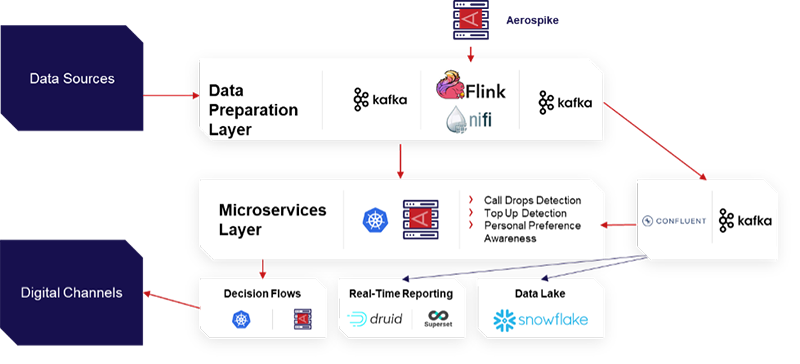An Avenue to Transform Communications Service Providers (CSP) into Digital Service Providers (DSP)
Telecom microservices is rapidly changing the way Telcos deal with their OSS/BSS and introduce new services to augment their connectivity revenue. Successful implementation of microservices depends on a few key capabilities – processing (and leveraging) data collected through different OSS/BSS being one of them. Along with high performance, the data platform also needs to be future-proof in terms of scale – that of course, without breaking the bank. Aerospike’s real-time data platform offers a combination of all these key capabilities. One of its major customers has laid out how telecom microservices built leveraging Aerospike are helping the operator in their transformation from a CSP to a DSP.
Microservices is an architectural concept that’s based on the principle of breaking down complex IT systems into multiple easily manageable and autonomous constituents, each of which addresses a particular task.
In contrast to the solution with a monolithic architecture, a microservices approach excels in agility, scalability, extensibility, and on-demand capability. This is a great enabler for personalized and omnichannel experience that’s fast becoming a table stake requirement from telecom end users.
Usually, microservices are deployed with Docker type platforms that package applications in isolated containers, which in turn communicate with each other through APIs. Apart from API development, microservices implementation requires expertise around DevOps, observability, efficient data processing at scale, and event-driven programming etc.
Data processing at scale is the area where high performance data platforms such as Aerospike add tremendous amounts of value. Most of the microservices based applications need real-time/near real-time response for both queries (read) and ingestions (writes). Many personalized offerings lose their appeal if the target user moves beyond the context of that offer. That’s why real-time matters. The other critical component is the ability to scale with a goal to make the platform future-proof. Here comes Aerospike again, with its inherent strength of ability to scale, thanks to the patented Hybrid Memory Architecture (HMA).
Today, microservices are widely used in telecoms in the following areas – Business Support Systems (BSS), Operations Support Systems (OSS), and network management. But, importantly it also enables a lot of new and innovative services that go a long way to Communication Service Providers’ (CSPs’) venture into non-telephony services- real-time cross-sell/upsell in gaming and mobile commerce, personalized campaign and/or rewards management etc. to name a few.
Aerospike helps one of its key Tier-1 telco customers in implementing exactly that. The telco publicly talks about its journey of transforming itself from a CSP to a DSP and how the Aerospike real-time data platform plays a central role in that journey. “As we transform us into a digital service provider, Aerospike is like our central nervous system” commented their Director of Streaming Data Event Sourcing Platform.
Specifically, the telco highlights how their streaming decision platform is used for rapid rollout of innovative use cases such as real-time streaming-based services (e.g. contextual marketing), upsell, campaign management with real-time reporting (in spite of massive transaction volume), and rewards management with effectiveness tracking etc. A very high-level architecture and Aerospike’s role within that enablement process is depicted below:

In summary, the architecture is based on the following flow – the data preparation layer takes feed from different data sources that include network interfaces, service assurance parameters, and digital footprint information, among others. The data preparation layer itself consists of multiple (on prem and cloud) kafka layers for data ingestion and a nifi/flink layer for data cleansing. That clean message then makes its way into the microservices layer.
This is where actions such as detections of call drops, top-ups, rewards, and other real-time events take place. From there on, multiple things can happen. The output can either go to a data lake or be fed into real-time reporting and/or decision layers to trigger the next action as set by the telco. Those actions are then pushed out through the preferred digital channel/s.
As mentioned earlier, from a data platform perspective, the core competency here lies with the ability to handle very high volumes of transactions at scale. That’s precisely what the telco talks about for their reason to choose Aerospike. For context, Aerospike’s highly scalable data platform improved the connections 10X (from 5K by RDBMS to ~50K). Similarly, the number of lookups saw a nearly 6X improvement (at 85M from the previous upper limit of 15M). Moreover, effort required in operating and supporting the Aerospike database has been very minimal. It has scaled and upgraded instances to maximize Aerospike with almost zero downtime. Last but not least, all of these performance and scale improvements were materialized with a very attractive total cost of ownership (TCO) as Aerospike’s highly efficient platform design keeps the server footprint minimal, which in turn keeps the opex, in particular, significantly low compared to competing solutions.
Another useful thing is the fact that the Aerospike data platform is deployment model agnostic. The ability to deploy the data platform on multiple key instance types of major hyperscalers is a big advantage, as microservices inherently benefit from cloud-based implementation.
Microservices are increasingly playing a dominant role for telcos’ architectural modernization and new services implementation. And we at aerospike, are very pleased to support that journey towards telcos’ digital transformation.
For more resources:
Hear directly from a major Tier-1 Telco on their
Feel free to send any queries to Aerospike’s telco subject matter expert
Don’t forget to register for the upcoming TM Forum webinar – “Microservices: paving CSPs’ path to the cloud” on September 8 to hear directly from TM Forum, Aerospike, and our telecom customer Globe.



